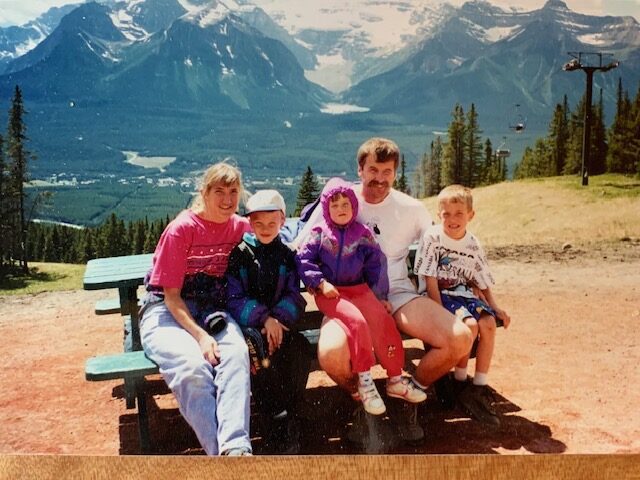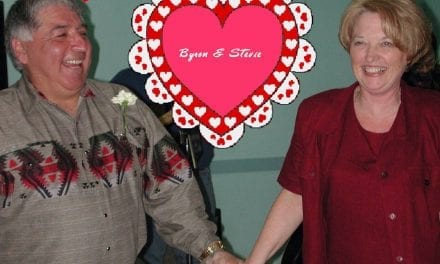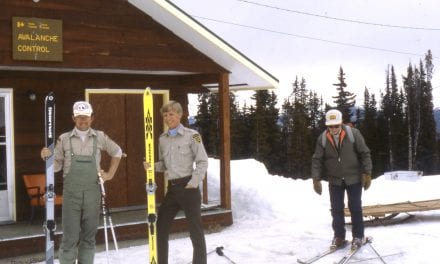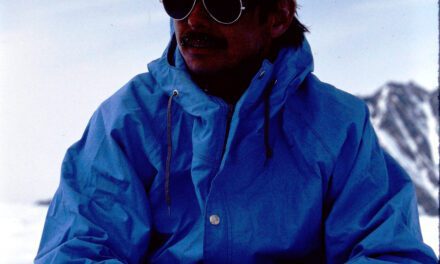Park Warden Service Alumni Society of Alberta
Oral History Project Phase 12 – Summer 2023
Telephone Interview with Hal Morrison
August 18, 2023– 10:45 am MST
Hornby Island and Invermere, BC
Interviewed by Susan Hairsine
SH: Good morning Hal. Let’s just jump right in here. What was the place and date of your birth?
Hal: I was born in Montreal in the year 1957.
SH: What was the date and month?
Hal: Oh, I don’t give that out.
SH: Okay, a secret. So where did you grow up Hal?
Hal: I grew up outside of Montreal in a little village called Terrace Vaudreuil. Later my parents moved closer to Montreal into a city called Lachine, and then they bought a farm when the FLQ crisis started happening, over the border in Ontario. So from 13 or 14 years old on I was kind of half at the farm and half in Quebec although I did finish my high school in Quebec.
SH: A true bilingual kid.
Hal: No not bilingual, I can make myself understood but it’s kind of rudimentary factory French.

The Morrison Family – Janice, Matt, Shyler, Hal, and Chad.
SH: How did you become involved in the Warden Service with that beginning?
Hal: I hitched across Canada when I was 17 and spent some time in Jasper at the free camp and went down to Banff and got a taste of the mountains, which was the beginnings of that. Then went and hung out in Vancouver and the area around there. I didn’t have in mind becoming a warden until I completed a Biosciences diploma at NAIT, and that’s where I met my wife, Janice.
I worked for Alberta power in Grand Prairie after getting out of NAIT. Janice and I met up in the fall, we had both quit our jobs and went out to my parent’s farm and joined the UI ski team. We also raised some calves for extra dollars, ice fished and rode and drove horses. I followed her up to the Yukon in the spring and we hung out in Haines Junction. Parks was having some competitions so we both threw our names in on both the warden competition and the interpreter competition and I managed to get a job out of the warden competition.
SH: What year would that have been Hal?
Hal: That was 1981.
SH: Did your wife also get a job out of that competition?
Hal: We both qualified for both competitions. I took the warden one and she selected the interpreter one. So, bingo bango, we became Parkies.
SH: So how long were you up in Haines Junction for?
Hal: I was in Haines Junction as a seasonal for two years and then for two years in Destruction Bay. So I spent four years in Kluane as a seasonal.
SH: What different parks did you work in? How did they compare? Do you have a favorite? So, let’s start with Kluane.
Hal: The first year I was in Haines Junction as a seasonal. What a cool park and what a cool job to have. Mostly it was all about training and getting acquainted with many areas of the park. Some of the small goals that seasonals were assigned, like doing an environmental assessment on a trail at Mush Lake and stuff like that.
Second year I was posted up to Sheep Mountain Cabin. It wasn’t a fun cabin to live at. There was no water near, and it was a dark little hole with not many windows and in the shade of the mountains most of the time. After a month of living there I moved into an old trailer in Destruction Bay where you could see the sun. Similar kind of goals that every seasonal has. The next year I was back in Haines Junction for a season and then back up to Destruction Bay next season. From there I competed on a …. at the time a permanent position was a GT02 and I competed on that and was successful on the list and was offered a job in Nahanni.
SH: I’m just going to back up to Haines for a moment. Who would have been the Chief Park Warden in those days and who else might you have worked with there?
Hal: At the time the Chief was Larry Tremblay and my supervisor was Ray Frey, he was the Area Manager in Haines Junction and Lloyd Freese was the public safety warden, Jim McIntyre, Ron Chambers, Rick Staley, Chuck Hume and a few others.
SH: It’s just nice to put that in perspective.
Hal: What era I was in eh? (Tape 7:08)
SH: Exactly. So then, you went up to Nahanni for a permanent position. Where were you living there?
Hal: When we left Kluane we didn’t have much for funds, we’d just got married a month or two before, or probably about 3 to 4 months before and I’d bought a new truck. So, we were pretty low on funds. They had sent us some information about Nahanni and what we would need to bring. In January when we were headed up there, the winter road into Nahanni Butte would likely be safe to travel on. The winter road is only in for about two months, they were thinking it would be built by then. Every year it has to be bulldozed and frozen and the river crossings have to have quite a bit of water pumped over top to make the ice bridge safe. Anyways, we knew we could probably drive into the Butte, we borrowed three thousand bucks from Janice’s parents and went down to Edmonton. Filled the truck right to the top with groceries and headed up the highway. It went down to about minus forty, and we had about 12 dozen hard frozen eggs. It was cold enough that even the jars of pickles were freezing and breaking.
We got to Fort Simpson and spent a few days there. Got info on the winter road, which was off the Liard Highway, which wasn’t really a highway, it’s a dirt road, a tunnel in the trees. So, we knew where to look for the trapper’s cabin that was our marker for the small road that goes in thirty km or so. Once that had frozen up enough, you could go in, so right around the time that we arrived in Fort Simpson, the winter road into the Butte had just opened up. So, we managed to get into the Butte and move into the trailer we were living in on the side of the airstrip.
SH: That’s great. How long were you in Nahanni for Hal?
Hal: Three plus years. It was an incredible park. I had the good fortune, of working in some really incredible parks, challenging, interesting, beautiful parks. So, Nahanni, I was the fulltime warden there. The winter compliment was a Chief Park Warden, a fulltime warden and a maintenance person.
SH: Who was the Chief?
Hal: At the time, Doug Eastcott and then Chuck Blythe. Doug was there about a year that I was there. The three families were, Doug and Cecile, Ivan Simmons (Maintenance man) and Senga and kids, and Janice and I. We didn’t have kids yet but we started there, so there were three families living year-round at the Butte. Seasonals included Chris Cooper, Peter Jowett, Murray Heap, Derek Petersen, Steve Catto and a few more that I can’t remember now. It was a remote setting, you were on generators, and it was a bit of a chore getting into the Butte and out of the Butte. Usually it was either by boat, ski doo or plane.
As a fulltime warden there, you needed to do everything or learn to do everything that needed to be done in an isolated post. That could be learning how to fix a furnace that broke because you only had a few hours before the trailer would start freezing up. You had to be able to repair or jury rig just about anything as well as be competent in jet boating, whitewater canoeing, skidooing etc. You had to get your skills up on a number of things. We still practiced and prepared for mountain climbing rescues, so Willi would come up usually once a year. Projects we were looking after included, Rabbitkettle Hot Springs visitation. It was becoming impacted, so how to allow visitation by canoers, that would either canoe down from higher the Nahanni or land at Rabbitkettle Lake and want to go see the tufa mounds.
SH: Sorry Hal, what is a tufa mound?
Hal: Well, there were some springs there, some warm water springs that were rich in calcium carbonate. So, they would flow over, repeatedly flow over these surfaces where they would start to build up Gower dams and you’d get some really fantastic looking structures that would be built up. The main mound at a guess I would say at least 30 or 40 feet high, and it was all little tiny terraces of this calcium carbonate precipitate. It’s pretty fascinating, it’s an interesting looking hot spring.
SH: Thanks, I’ve never heard of that before.
Hal: There was a wildlife component; monitoring what was going on with wildlife in the park. There was caribou, bison were just a small herd of about 25 and they hadn’t really taken off yet. It was always interesting to see what they were up to. There was always a few caribou around, moose and such and as well there was plenty of bears, and wildlife human conflict was dealt with, especially with black bears, it was a bit more cut and dried than what we tried to do in later years.
SH: Yes, and I guess you’d have foxes and all that sort of stuff too? (Tape 14:45)
Hal: Ya, pretty much everything under the sun; foxes, otters, lynx, beaver …. the whole range of furry critters. It was always interesting in the winter when we were skidooing, you’d either be using trappers’ trails or the river if the river was passable. Sometimes there was too much overflow which was always sort of a constant danger. When the ice got too heavy, or certain conditions existed when the ice was overlaid by quite a bit of snow it would push the ice down and water would seep up overtop, and now there’s this insulating blanket of snow. So, it would look like the snow -covered river was quite nice for traveling on with a skidoo or with skis, but it wasn’t because but as soon as you penetrated through that snow, you got into this kind of molasses like layer of super cold water that was not frozen, but just laying on top of the thick ice underneath. If you got a skidoo stuck in that it was just a big ordeal trying to get it out of there and if you didn’t get it out fast enough then because you’d broken the surface of the snow, it would just freeze hard into it and if you couldn’t get it out in one day, you’d have to go back and chop it out with axes. It would turn into a big thing.
SH: Did you have to do that?
Hal: Oh ya.
SH: Would you be just frozen? You must have got wet?
Hal: Ya, you would get wet, nobody was happy. It would be a long, frozen chore and at some point, you may be building a fire to get warmed up so you didn’t get frostbite as well and such. That was also a bit of an issue when you were crossing either the Nahanni or the Liard on the winter road. It would be plowed by the cat, but sometimes the overflow would come over top of the ice, and because it was exposed to the air and not covered by snow, it would form a bit of ice, maybe an inch or two thick, depending on when that overflow had happened and if you were driving, it just looked like a frozen surface. So, you’d be driving a truck or whatever, a vehicle, and if you broke through that, you’d go through whatever water was trapped underneath, six or eight inches or something, but then there’s good hard ice under that, but it would certainly give you a heck of a start when you broke through. You weren’t sure how it was going to play out.
SH: Would the skidoos get wet so they’d be difficult to start up in some of these adventures?
Hal: Typically, the overflow wasn’t super deep. It wasn’t like engines were being submerged.
SH: But you’d get wet. I can just picture how cold that would be.
Hal: Yes, my wife Janice dropped our car…our last year there we brought a car up…and she went through the overflow just outside of the Nahanni Station at the Butte, and the amount of unfrozen water was about 12 or 14 inches, so the car kind of lurched front down, and she was stuck and couldn’t get out of there. We’d had our first son by then, so she had the kid in the car too. So, it was a bit of a start for her, and also there’s the brand-new car looking like it’s making a nose dive into the Nahanni River before I pulled it out with the tractor.
SH: Adventures in a marriage.
Hal: Ya. She was pretty good natured and adaptable, she rolled with it.
SH: Do you want to continue with Nahanni or where did you go after that?
Hal: At Nahanni I was also the Acting Chief Park Warden for six or seven months, and I was acting Maintenance Supervisor for about seven or eight months. I ended up going to a Maintenance Managers’ conference in Winnipeg which was pretty funny because most of them knew each other and they were trying to figure out who the heck I was. I explained I was a warden who was just pinch hitting as a maintenance supervisor up in Nahanni. There were a lot of raised eyebrows.




This was a great read, glad I had the pleasure of working with Hal in Cape Breton Highlands National Park . Janice used to make us a wicked cup of “stake out “ coffee to take out on night time poaching patrols.